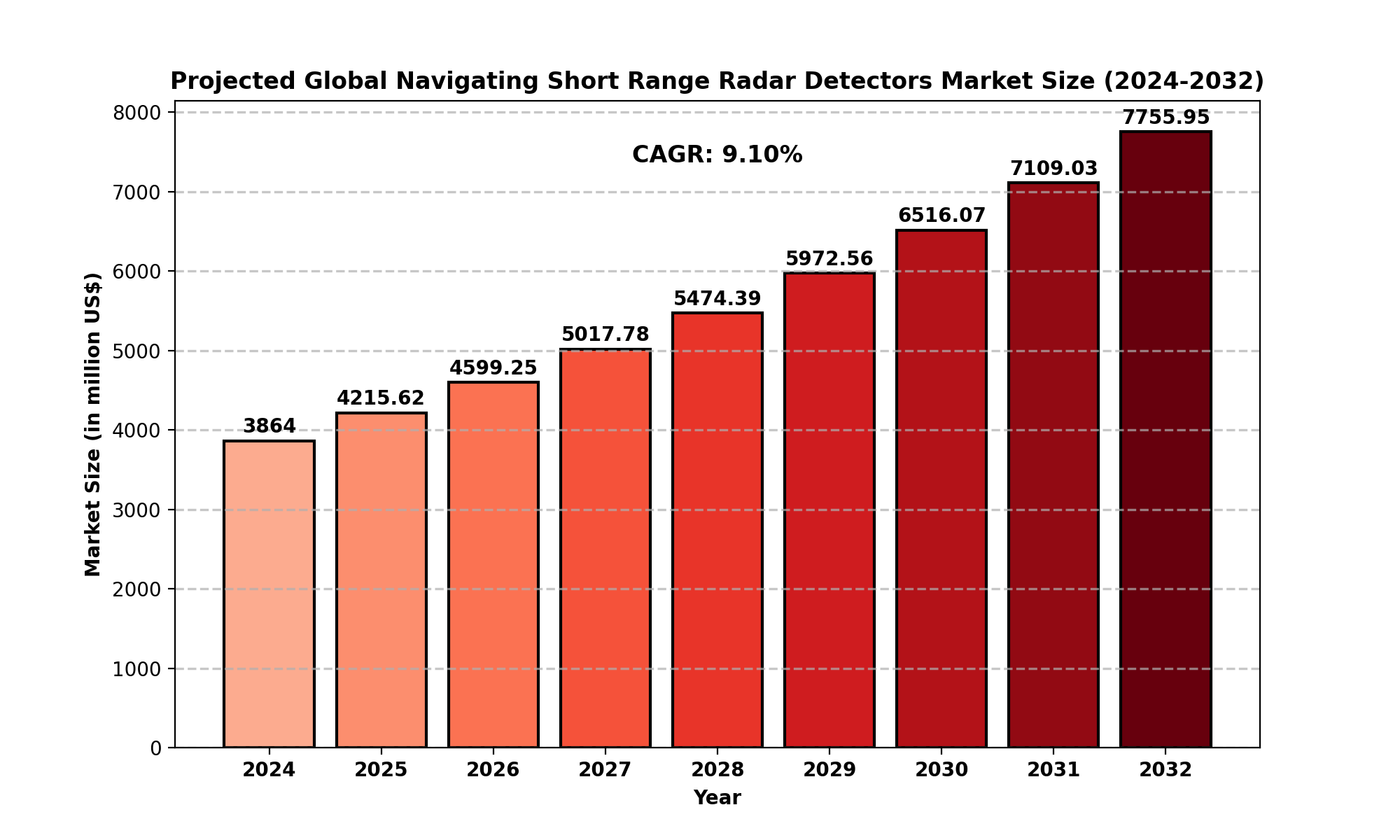TOP CATEGORY: Chemicals & Materials | Life Sciences | Banking & Finance | ICT Media

Download Report PDF Instantly
Report overview
Navigating short-range radar detectors are essential maritime navigation systems designed to detect and monitor objects within a limited range. These detectors are used to enhance navigation, collision avoidance, ship positioning, and narrow channel navigation. The core functionality involves emitting wavelet electromagnetic waves and receiving echoes to determine the range, angle, or velocity of targets. They are indispensable in providing mariners with observation capabilities during poor visibility and adverse weather conditions. The ability to detect both stationary and moving objects reduces the risk of accidents, making these detectors vital for maritime safety.
The global navigating short-range radar detectors market was valued at USD 3,864 million in 2024. This market is projected to grow significantly, reaching USD 7,755.95 million by 2032, with a compound annual growth rate (CAGR) of 9.10% during the forecast period.
North America, a key regional market, was estimated to have a market size of USD 1,170.04 million in 2024, with a CAGR of 7.80% expected from 2025 through 2032.
Key Statistics:
2024 Global Market Size: USD 3,864 million
2032 Projected Global Market Size: USD 8,461.74 million
CAGR (2024-2032): 9.10%
2024 North America Market Size: USD 1,170.04 million
North America CAGR (2024-2032): 7.80%

Drivers
Increasing Maritime Activities: Growing global trade and rising recreational marine activities drive the demand for advanced navigation systems.
Safety Regulations: Stricter maritime safety regulations encourage the adoption of radar detectors to minimize accidents.
Technological Advancements: Innovations such as improved radar resolution, compact designs, and integration with GPS systems fuel market growth.
Restraints
High Initial Costs: The significant cost of installation and maintenance may deter small-scale operators.
Technical Limitations: Radar detectors have limitations in detecting small objects or in highly cluttered environments, affecting their reliability.
Opportunities
Emerging Markets: Developing regions are increasingly investing in maritime infrastructure, offering untapped growth opportunities.
Integration with AI: Incorporating artificial intelligence for predictive analysis and enhanced functionality can drive innovation and adoption.
Challenges
Weather Interference: Extreme weather conditions can impact radar performance, posing operational challenges.
Skill Gap: A lack of trained personnel to operate and maintain radar systems could hinder market growth.
North America
North America is a leading region, driven by the high adoption of advanced maritime technologies and robust safety regulations. The region’s market is expected to grow steadily, with significant contributions from the U.S. and Canada.
Europe
Europe’s market is characterized by strong investments in maritime safety and the presence of established players. Countries like Germany, the UK, and France are at the forefront of adopting advanced radar technologies.
Asia-Pacific
Asia-Pacific is the fastest-growing region, fueled by rising maritime trade and increasing investments in infrastructure. Key contributors include China, Japan, South Korea, and India.
South America
The region exhibits moderate growth due to improving economic conditions and investments in port modernization. Brazil and Argentina are the primary contributors.
Middle East and Africa
The Middle East and Africa have emerging markets driven by increasing trade activities and investments in maritime infrastructure.
Major Players:
Furuno Electric
Lockheed Martin
Northrop Grumman
Raytheon
Saab
Japan Radio
BAE Systems
JRC (Alphatron Marine)
Garmin
Wartsila Sam
FLIR Systems
Navico Group
GEM Elettronica
HENSOLDT UK
Koden Electronics
Rutter
Kongsberg Maritime
TOKYO KEIKI
Johnson Outdoors
These companies are recognized for their extensive product portfolios, technological expertise, and strategic market presence. Competitive strategies include mergers, acquisitions, partnerships, and continuous innovation to meet the evolving demands of the maritime industry.
Merchant Marine: Used for cargo transportation and commercial shipping.
Fishing Vessels: Aids in navigation and fish-finding capabilities.
Yacht: Enhances safety and navigation for leisure boating.
Military: Used for tactical navigation and surveillance.
X Band Radars: High frequency, suitable for detecting smaller targets at short range.
S Band Radars: Lower frequency, effective for long-range detection and adverse weather conditions.
The competitive landscape features leading manufacturers such as Furuno Electric, Lockheed Martin, and Northrop Grumman. These companies leverage cutting-edge technologies and strategic partnerships to maintain market dominance.
North America: USA, Canada, Mexico
Europe: Germany, UK, France, Russia, Italy, Rest of Europe
Asia-Pacific: China, Japan, South Korea, India, Southeast Asia, Rest of Asia-Pacific
South America: Brazil, Argentina, Columbia, Rest of South America
Middle East and Africa: Saudi Arabia, UAE, Egypt, Nigeria, South Africa, Rest of MEA
What is the current market size of navigating short-range radar detectors?
The global market size was estimated at USD 3,864 million in 2024.
Which are the key companies operating in the navigating short-range radar detectors market?
Leading companies include Furuno Electric, Lockheed Martin, Northrop Grumman, Raytheon, and Saab, among others.
What are the key growth drivers in the navigating short-range radar detectors market?
Key growth drivers include increasing maritime activities, stringent safety regulations, and technological advancements.
Which regions dominate the navigating short-range radar detectors market?
North America and Asia-Pacific are the dominant regions, with significant contributions from Europe.
What are the emerging trends in the navigating short-range radar detectors market?
Emerging trends include integration with AI, enhanced radar resolution, and growing investments in maritime infrastructure.
Industry drivers, restraints, and opportunities covered in the study
Neutral perspective on the market performance
Recent industry trends and developments
Competitive landscape & strategies of key players
Potential & niche segments and regions exhibiting promising growth covered
Historical, current, and projected market size, in terms of value
In-depth analysis of the Navigating Short Range Radar Detectors Market
Overview of the regional outlook of the Navigating Short Range Radar Detectors Market:
Access to date statistics compiled by our researchers. These provide you with historical and forecast data, which is analyzed to tell you why your market is set to change
This enables you to anticipate market changes to remain ahead of your competitors
You will be able to copy data from the Excel spreadsheet straight into your marketing plans, business presentations, or other strategic documents
The concise analysis, clear graph, and table format will enable you to pinpoint the information you require quickly
Provision of market value data for each segment and sub-segment
Indicates the region and segment that is expected to witness the fastest growth as well as to dominate the market
Analysis by geography highlighting the consumption of the product/service in the region as well as indicating the factors that are affecting the market within each region
Competitive landscape which incorporates the market ranking of the major players, along with new service/product launches, partnerships, business expansions, and acquisitions in the past five years of companies profiled
Extensive company profiles comprising of company overview, company insights, product benchmarking, and SWOT analysis for the major market players
The current as well as the future market outlook of the industry concerning recent developments which involve growth opportunities and drivers as well as challenges and restraints of both emerging as well as developed regions
Includes in-depth analysis of the market from various perspectives through Porter